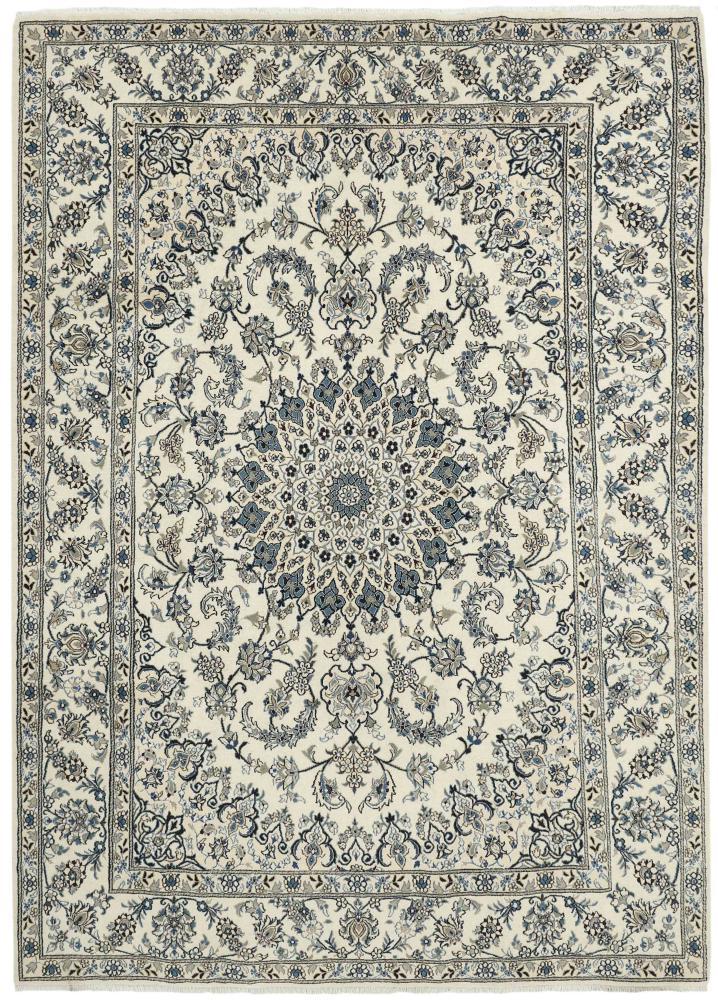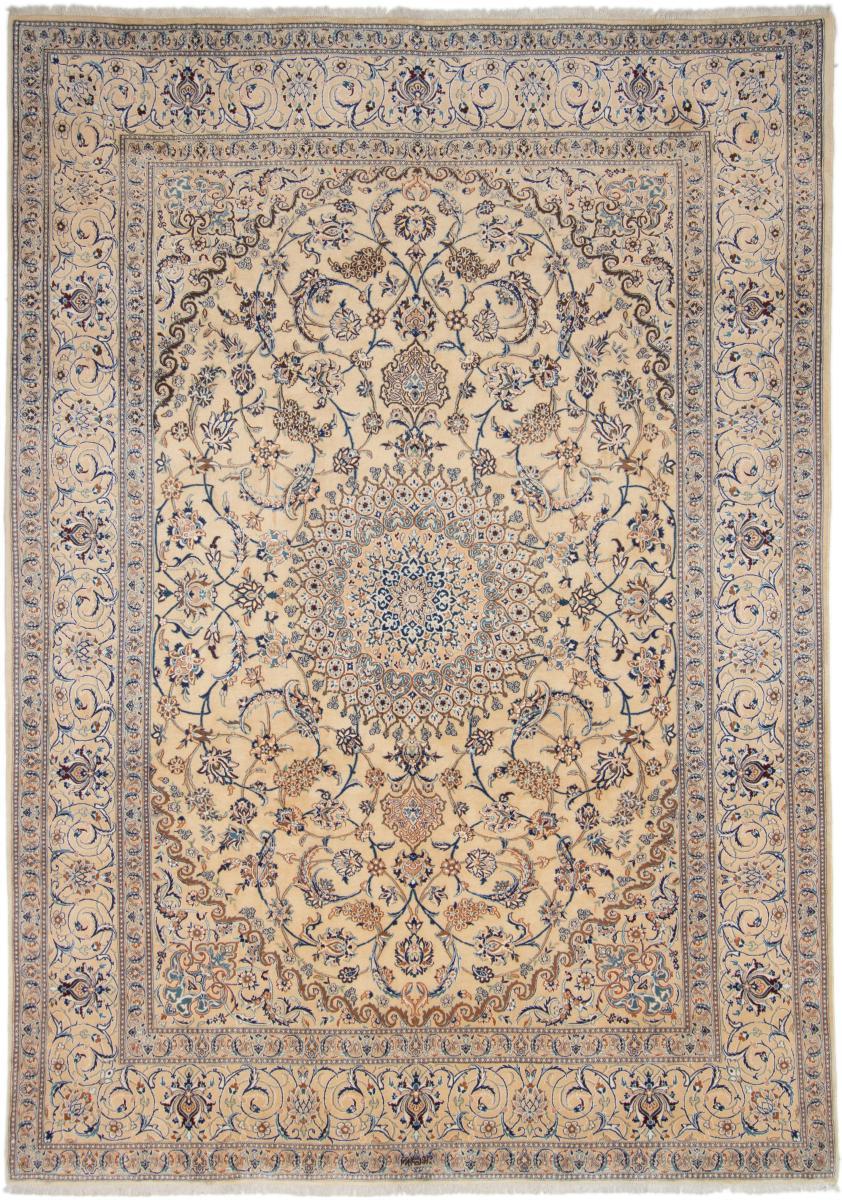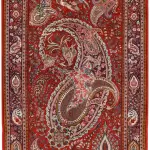Naeen handwoven carpet and its features
Naeen city is one of the provinces of Isfahan province, taking into account the desert, its borders reach Isfahan, Ardestan, Yazd, Semnan and Tabas. Naeen city consists of three parts of Naeen city and suburbs, Anark, Khor and Biyabank, which includes 13 rural districts and 830 villages. Naeen is a desert region, but due to the location of a high mountain in its southwest, it has a moderate climate. In the Middle Ages, this city was considered part of the Fars state. Later, until the reign of Naseruddin Shah, it was a part of Yazd and from this date onwards, it was part of Isfahan. Despite the fact that the Naeen carpet is not considered an old profession in this region historically, today it is considered one of the most exquisite Iranian carpets due to the elegance and quality of its special texture and coloring. In this article, we will introduce the characteristic features of Naeen handwoven carpet.
Culture and art in Naeen
Naeen is a traditionalist city that, despite some external changes, has accepted little change in terms of texture and economic structure. The production of cotton fabrics such as karbas and motagal (due to the presence of cotton in the region has an old history), zilo weaving, carpet weaving and felt weaving, bark weaving has been one of the common occupations in the region; But the most famous product of Naeen, at least in the last century, was the robe, which was produced in special workshops in the suburbs of Naeen, and Naeen robes were famous in all Islamic countries. This reputation shows the existence of skilled craftsmen in the weaving of robes and very fine fabrics. Most of the cloth-weaving workshops in Mohammadieh village have existed in the crypts.
Records of carpet weaving in Naeen
Studies show that there is no example or document of the history of carpet weaving in the Naeen region even in the Safavid period, which is the peak of the art of carpet weaving in Iran. It can be assumed that the boom in the production of robes and fabrics has not provided the possibility of growth in the field of carpet weaving. Later, with the boom of industrial textile production, traditional textile industries such as Kerman shawl weaving and Naeen robe weaving declined and since then, carpet weaving was formed in this region. Ababaf artisans in Naeen started producing very fine carpets. The first economic communication center for the sale of Naeen carpets was Isfahan. With the passage of time and the production of high-quality and elegant carpets, Naeen carpets reached the level of competition with Isfahan, Kashan and Arak carpets. With the start of World War II and the recession in the international carpet markets, Abba Bafi flourished again. But in the end, the skill of Naeen artists and weavers in preparing the fine wool skeins that they previously used in the weaving of thin fabrics, this time was used in the weaving of finely woven rugs, and it made Naeen handwoven carpets with finer and softer wool fibers than Other areas are woven. This also caused that despite the fact that the production of Naeen carpets is small in terms of number, it was able to gain many fans in the domestic and foreign markets. Currently, among Iranian hand-woven carpets, the Naeen carpet is considered one of the most exquisite carpets in Iran due to its elegance and special coloring.
The effect of Isfahan's design on the Naeen carpet
At first, Naeen carpets were woven according to Bakhtiari, Isfahan and Yazd designs, but after the Second World War, they found their own design and role and found a special place for themselves among the collection of Iranian designs. Although, along with independence in design and role, the roots of connection with the mother city (Isfahan) have not been cut. From the point of view of some researchers, such as Eric Aschenbrenner, in the design of Naeen carpets, there are traces of the influence of Shah Abbasi's design, which are inspired by the palaces of Isfahan. It is visible.
Features of Naeen original carpet
Iranian handwoven carpet has its own characteristics in each production area. In fact, one of the distinguishing features of Iranian carpets is the variety of styles according to the region of production. In the same way, Farsh Naeen found an independent identity with its own characteristics, which is still known today. In the following, we will describe the characteristics of Naeen carpet in terms of materials, design, pattern, color and texture.
Materials and materials in Naeen carpet
The buying and selling criteria and the value of Naeen carpets are often based on the number of layers of thread, because the thickness of the thread plays an important role in determining the final elegance of the carpet. Naeen carpets are woven using cotton thread (four la, six la and nine la) and the mentioned number means the number of threads spun in each warp or chela. For example, four-layer yarn means that 4 strands of thin yarn are woven together to make warp yarn. Therefore, the fewer the number of threads, the finer and better the carpet. The color of the carpet, its design, the quality of the texture and the skill of the weaver are other factors that are effective in determining the final price of the Naeen carpet. In the Naeen carpet, fluff or fine wool is usually used for pile. Naeen carpet is one of the rare and suitable examples of fine non-Iranian wool. Silk is used to a limited extent in flowers and ribbons. In fact, most Shah Abbasi flowers and Slimis are characterized by a row of white silk. This makes the motifs stand out because of the shine and luster of the silk. Silk floor carpet is not common among Naeen carpets.
Designs and patterns in the Naeen carpet
The design of Naeen carpets is diverse, but the main designs are Shah Abbasi Lakh and Toranj, using Slimi, Khatai combinations and patterns in general, which are related to the most traditional designs of Iran. In general, the types of shah Abbasi laces and tranjs and Afshan motifs are seen on Naeen carpets more than any other design, and Naeen carpets are often known with the pattern of ligh and tranj on a light color background. Other common motifs in carpet weaving in this region include dome (ceiling), haj khanami, tree, frame, mihrabi, mahramat, historical, afshan and inscriptions. The design of Haj Khanami or vase is mostly woven in the old carpets of Naeen city and its use is rarely seen these days. The main characteristic of this design is the presence of a vase in the center of the carpet, which is surrounded by tangled stems and flowers. The dome design is also woven in some other carpet weaving centers of Iran and is inspired by the dome motifs of historical and religious places. In addition to the cases mentioned as common designs in the Naeen carpet, the carpet designers of this city sometimes combine Slimi and Khatai patterns with other motifs to create a beautiful and unique design, and this creative design is called "combination".
Naeen carpet is full of designs and patterns
In general, in Naeen carpets, the motifs often cover the entire surface of the carpet, and there is rarely an empty space on the surface of these carpets. In a general view, the original Naeen carpet is luxurious and full of details, and this is what has made it famous worldwide. Recently, the creative weavers of Naeeni have started to weave all kinds of side, round, hexagonal and octagonal carpets.
Color in Naeen carpet
Naeen handwoven carpets, although they do not have much variety in coloring, but with the same composition and number, they have an admirable beauty. In fact, the type of coloring used in Naeen handwoven carpet makes it completely distinguishable from carpets in other parts of Iran. The colors in Naeen carpets have a cool tonality and often include white, pea, khaki, cream, turquoise, sky blue, navy blue, pistachio green, beige and rarely red. Jade, mashi, green, copper, pink are among the secondary colors that are sometimes seen among the color combination of carpets in this region. Each of the mentioned colors can be seen in dark and light tones in the texture of Naeen carpets. The background in these carpets is often cream or pea colored and this is one of the main characteristics of Naeen carpet. Dyeing of fibers for carpet weaving in Naeen is done using both natural dyes and chemical dyes with high quality and color stability. The use of natural dyes such as pomegranate skin, walnut skin, hair leaves and runas are very common in this region.

How to weave, knot and shirazeh in Naeen carpet
All Naeen carpets are woven with a Persian knot (asymmetrical), and the use of two wefts after each row of weaving. Chelekshi in Naeen carpets is also done in Persian style and on vertical dars. In the past, the dars of this area, like many other carpet weaving areas in Iran, were made of wood, but now metal dars are used. In general, the method of weaving and weaving in the carpets of this region is very similar to Kashan and Isfahan. Shirazeh in the carpets of this region is done at the same time as the weaving, and the two ends of the rug are woven. Finishing in Naeen carpet is also done manually while weaving and using scissors. Naeen carpets have relatively short piles. Genuine Naeen carpets have a coherent and uniform texture and are of high texture quality. Defects such as crookedness, head, not wefting, wrong weaving, knocking, splitting and multi-coloring are not usually observed in Naeen carpets. It is common to use single-pair and double-pair knots in Naeen carpets. Naeen rugs often have a count between 50 and 70 knots per 6.5 cm, which is why rugs from this region fall into the fine weave category. The dimensions of the Naeen carpet are diverse and except for the side, the texture of other types of carpets is common in this region in terms of dimensions. But the most common dimensions in Naeen carpets are 6 and 9 meter carpets.
Prominent Naeen carpet weavers and designers
Master Fathullah Habibian Naeeni, Mofidi brothers, Haj Reza Qanbari and Jalal Banda Ali are among the most famous weavers of Naeen carpets. Fethullah Habibian is one of the most famous and skilled masters of Naeen carpet weaving, who not only personally designed all the carpets produced in his workshops, but also supervised the weavers who were commissioned to work on his works. Also, among the old and new prominent designers of Naeen carpets, we can mention people such as Sheikh Hassan Mattouli, Akhwan Mofidi, Jahan Mofidi, Reza Yousefpour, Mohammad Ali Rahnian Mohammadi, Hassan Talhani and Jahangir Talhani who have designed very beautiful motifs for authentic Naeeni carpets.
Features of non-authentic Naeen carpet
Due to the boom in the domestic and foreign sales market of Naeen carpets, today many areas such as parts of Isfahan province such as Ardestan and Biyabank, and distant areas such as Khorasan and its cities, Semnan, Tabas, Qazvin, etc., are producing carpets with an appearance similar to They turned to Naeen's carpet. In general, the difference between these products and the carpets produced in Naeen is the quality of the carpet. Although there may be exceptional cases. Knowing the characteristics of non-original Naeen carpets or similar to Naeen carpets, can help you distinguish genuine Naeen carpets. In the following, we will examine the main features of carpets similar to Naeen.
Raw materials in non-authentic Naeen carpets
In this group, Cheles are cotton, the percentage of viscose of these Cheles may be higher and they are not specifically cotton. Lining is made of synthetic silk (similar to cotton) or poor quality and tanned wool. The dyeing of these fibers is usually completely chemical and the dyeing quality is low. Threads with a high percentage of plastic are used for the weft.
Design, pattern and color in non-original Naeen carpets
The design of these carpets is similar to the design of original Naeen carpets and is actually copied from famous and old designs. On the other hand, since there is no requirement for the producer to observe and use the traditional design and role of the region, it is sometimes seen that a design or role from other regions such as Tabriz is included in the Naeen style carpets with the intervention of the producer. The general theme of the colors used is the same cold, cream and earthy tonality.
Non-authentic Naeen carpet weaving technique
The texture of these carpets is woven on Persian challah with a double knot or without a knot (U shape). These carpets are often made of multiple folds and sometimes shirazeh is sewn to it separately at the end of the work. In some areas, due to the use of knotless weaving to compensate for the damage, they use wire instead of thick weft to restore the lost strength to the carpet. According to the mentioned cases, the non-original Naeen carpet is at a much lower level than the original Naeen carpets in terms of quality. It is very helpful to consider these features when buying a genuine Naeen carpet.
You can inquire about Buying Handwoven Carpets , Buying Handwoven Kilim and Mats , and Buying Handwoven Pictorial Rug Tableaus online from the Hoveida Carpet Store and register all your orders and Wherever you are in the world, deliver it to the desired address in less than 4 working days.
If you are interested in reading other articles in the field of Handwoven carpets or Handwoven Pictorial Rug Tableaus , please refer to Hoveida Carpet Commercial
Leave a comment
Your email address will not be published. Required fields are marked *












